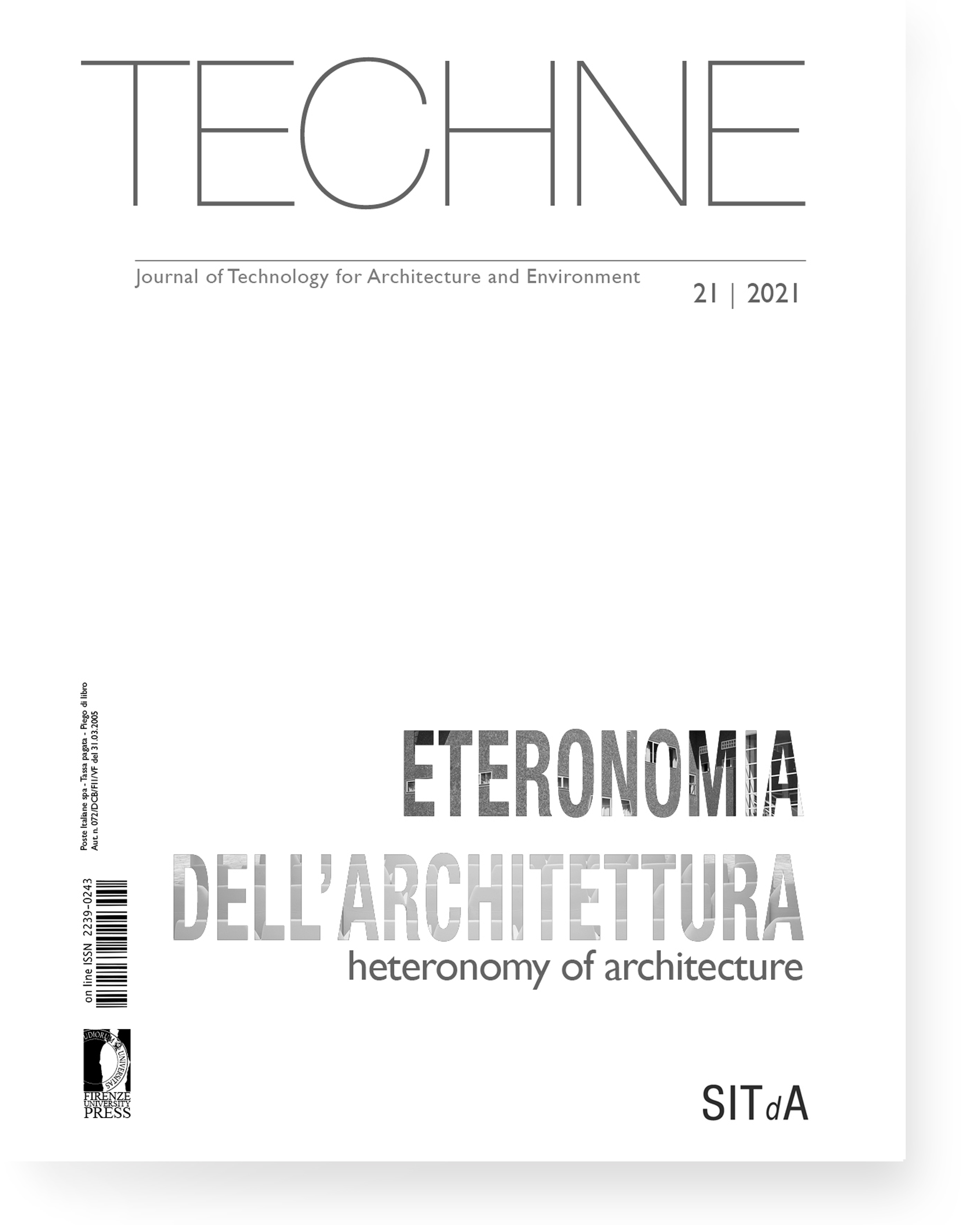Published 2021-02-23
How to Cite
Abstract
Heteronomy of Architecture. Between hybridization and contamination of knowledge. A complex and inexhaustible theme, stratified over time through theories and practices favouring the necessity of an Architecture dependent and correlated with other disciplines and external factors, as opposed to the Autonomy of Architecture idea. It finds the reasons for its being and manifesting itself in its disciplinary specificity and uniqueness
E. Morin1, in “I sette saperi necessary all’educazione del future” (I ed. 2001) denounces the need for a new form of knowledge, proposing seven conditions or categories to reorganize in a transdisciplinary way the thought and education of every society and culture, able to lay the foundations for the education of the future.
The need for knowledge, training and complex critical consciousness, shows itself in Architecture in all its contradiction, in a society that develops figures more and more dangerously specialized and decontextualized concerning the opportunity – taking up the thought of Morin’s text (2001) – that education should «promote a “general intelligence” capable of referring to the complex, to the context in a multidimensional way and to the global».
In this context, the Reviews section highlights three texts that, to the Topic Heteronomy of Architecture, over the last few years and according to a method common to the previous issues, represent three specific aspects. The first deals with the subject in a disciplinary context, proposing reflections on the role of the architect as an educator, together with his responsibility to transfer and acquire knowledge; the second, of a general nature but referable to the Architecture Area, also proposes a reflection on the task of the architect, but in this case in his role of intellectual and critic for contemporary society; the third is a critical essay on the Topic that questions the function, more generally, of Architecture for our present and our future.
The first text – “Insegnare l’Architettura, Due scuole a confront” (also published in English and Spanish) by E. Faroldi and M.P. Vettori (2020), Letteraventidue is reviewed – by O. E. Bellini2. The text explores the complexity and meaning of teaching design, looking at Architecture as a complex discipline. In which, knowledge is hybridised, comparing, through fifteen author’s dialogues, the polytechnic matrices of the School of Architecture, Urban Planning and Construction Engineering (AUIC) of Politecnico di Milano and the Escuela Técnica Superior de Arquitectura de Madrid (ETSAM) of Universidad Politécnica de Madrid, as experiential places of training and learning to face the challenges of the complexity of our age. O.E. Bellini interprets and transfers the authors’ intention to highlight the intellectual dimension, the emotional transport and the personal identity of being a teacher, recounting through references and quotations the role of in-signare as the act of impressing a signum, a mark, an imprint on the learner, generating cognitive and two-way processes that lead to the transmission of knowledge.
The debate on the architect’s role and the responsibility of acquiring and transferring knowledge at all levels in society extends to the second text – “L’architetto come intellettuale” by M. Biraghi (2019) Piccola Biblioteca Einaudi, Bologna – reviewed by M.F. Ottone3. The text, recounting the crisis of the architect’s role in the contemporary context, analyses the figure of the architect as “intellectual” throughout history, reporting references that support the thesis, comparing it with the almost ancillary role of recent decades, due to a parcelling out of knowledge that has weakened its social and political contribution. M.F. Ottone reviews the text analytically, focusing on the history of the architecture discipline, highlighting key figures and quotations that describe a context characterised by “complexities and contradictions” that emerged at the beginning of the century. In particular, there is the double figure of the architect-producer, capable of taking a leading position in design processes, as a mere executor of products within an economic dynamic, the supplier’s figure is devoted to satisfying essentially ordinary needs. A text, therefore, that poses many unresolved questions at a time of crisis in architecture and its relationship with its time, with the current era, similar to the third text – “Habitat 5.0. L’architettura nel Lungo Presente” by M. Ricci (2020) Skira, Milan – reviewed by A. De Capua4.The essay, accompanied by the writings of A. Branzi, N. Pugno and C. Ratti, recounts the crisis of an era through the inertia of change in the forms of living in the long present, about the digital revolution and 5.0 technology, drawing attention to the need for the uniqueness of a profession that is all too articulated in specialisms. A. De Capua describes the text with great emphasis, as a journey that starts from the three fundamental questions for the author’s architecture: time, space and meaning, questioning the new concept of time and the need for a new path towards quality, culture and beauty. The need for a new architect figure, less imbued with disciplinary and academic logic and more attentive to the re-education of beauty, concludes the review through quotations and comments highlighting the author’s profound transdisciplinary vision and his vision of the future.
In their revaluation of the hybridisation of knowledge at a global level, the three texts raise critical, technical and social questions about our time’s specificity and the difficulty of a cultural and architectural identity that is recognisable and congruent with the dynamics of the context. The needs for education and training for the future, to paraphrase Morin, are the pivotal points around which the three texts revolve, and they have found sap and opportunity to contribute to a debate that will continue to manifest its uncertainties, dichotomies and visions towards new models of knowledge and knowledge transfer in the future.






